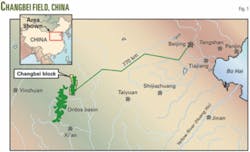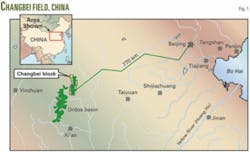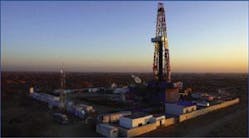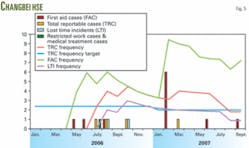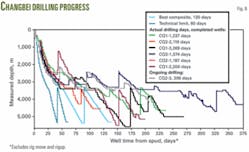To supply gas for the Olympics, Shell is drilling the longest horizontal wells ever attempted in mainland China. In the process, the company has had to assess and overcome significant cultural differences in working procedures, establish a sound local organization committed to stringent HSE standards and improve preventive maintenance scheduling and drillstring management.
Cultural differences between West and East often create problems or tensions for a western company like Shell when carrying out projects in very remote regions, such as the Changbei project in China’s Ordos basin (Fig. 1).
Shell had drilling experience in the area, including Subei (1993-94), Qingshui (1998-99), and the recent Bonan (offshore, Bohai Bay) and Chang projects; but nevertheless, the company could not underestimate the huge difference in culture.
The Changbei project is Shell’s largest onshore foreign investment and the company’s first operated development project in China, with a total capital expense final investment decision (FID) of $644 million. The 1,588 sq km field lies on a remote, semiarid plateau, 1,200 m above the sea in rural China, raising issues about the working temperatures, logistics, and material availability. The typical land climate makes for hot, dry summers with dust storms and long, very cold winters with winds that cut right through personal protective equipment, due to the lack of natural barriers. The local farming community is well adapted to the conditions.
Amid this, Shell has managed to drill and complete six high-producing, multilateral, horizontal, extended reach gas wells. The company built gas processing facilities to export the gas to Beijing.
In this projectthe largest onshore Sino-foreign exploration and production venture to dateShell partnered with Petrochina, one of the world’s biggest oil companies, which contracts three rigs from local drilling companies. Two rigs come from Liaoche Petroleum Exploration Bureau, based in Panjin, and the third from Changqing Petroleum Exploration Bureau, based in Xian (Fig. 2).
Within the Petrochina tree of companies, these two drilling companies are rivals, generating a competition to operate the best-performing rig in Changbei. The local drilling contractors aim to gain a strategic advantage through the experience gained working with an international oil company such as Shell.
The Chinese-built rigs under contract to Shell are the best-specified rigs available onshore China. These local rigs come with local crews that have an operational hierarchy very different from that of international drilling contractors. The so-called ‘Ling Tau’ system (literally ‘master’) weaves in a difficult political angle for Westerners that is common in state-owned companies. Nevertheless, everyone in the Changbei team is proud to claim success in reaping the benefits of both cultures to improve drilling performance and HSE standards.
Development plan
Changbei field is part of the immense Ordos basin, in the southern Gobi desert. This is the world’s third largest desert and the coldest, where various operators are developing oil and gas fields. The area is also known for its vast coal deposits. This is brought to light on a regular basis, when heavily overloaded coal trucks are seen passing through Shell’s concession area, or when the winter cold makes the villagers fire up coal-burning ovens, covering the sky with a thick mist or smoke.
The Changbei field covers a very large area, but the tight reservoir sand is only 0-40 m thick. This factor drove the design and installation of 54 long-reach, single and dual horizontal wells, drilled from 23 clusters that contain up to 3 wells each (Fig. 3).
Due to the hard overburden, costly land acquisition and facility installation, and to minimize surface impact in a protected area, two 2,000 m horizontal laterals were drilled in order to optimize the drainage area in proportion to the number of clusters. The base casing scheme that was adopted for the project includes driving a 20-in. conductor to refusal and drilling a 16-in. hole into the Yangchang formation. This is strong enough to take a gas kick from the reservoir. After setting 133⁄8-in. casing vertically around 700 m depth, a very long 12¼-in. section is drilled, kicking off deep and building up through various clay and coal sequences. This section lands horizontally in the Shanxi formation sandstone (pay zone), around 3,450 m along hole (about 2,900 m TVD).
The 95⁄8-in. production casing safeguards the overburden for drilling the two 2,000 m laterals that are completed barefoot. The 13-chrome completion is a relatively simple one, including a tubing retrievable subsurface safety valve (TRSSSV) on 4½-in. tubing and a packer at wireline-capable depth (Fig. 4).
The well services team in Changbei runs the completions, and when the rig has left, it carries out nitrogen lifting with coiled tubing. Subsequently, the well is cleaned up at the site before it is hooked up to flow it to the central production facilities.
Reservoir
The pay zone is a Permian braided river deposit, very heterogeneous, and hence difficult to correlate between new well and existing vertical wells (previously drilled by Petrochina). Although the sands are relatively clean, baffles of claystone are regularly encountered, which cause concern for wellbore stability during drilling and production.
Currently, two simple but effective strategies have been adopted to deal with the often very hard but sometimes fragile claystone formations. If the carbonaceous content is high and hole problems are expected, an openhole sidetrack is drilled and the well path ducks under the claystone to continue drilling better sands. If, however, the claystone cannot be avoided, and is deemed unlikely to collapse during drilling, but could be at risk of collapsinge during the production phase, the team installs a predrilled liner, either dropped off over the interval at risk, or hung off the production casing.
Early development plans included underbalanced drilling (UBD) as a way to minimize reservoir impairment. Theoretically, this would be a good technology to use in Changbei’s tight sandstones, but plans were put on hold due to certain findings. There was good production from the first wells, borehole stability problems with the claystone in the reservoir, and the company studied potential problems with emulsions that can form between reservoir fluids and nonaqueous drilling fluids.
The early dual-lateral wells flowed about five times better than the vertical, hydraulically fractured wells. More recently drilled dual-laterals show even better production rates.
Organization
The Changbei Wells project started in 2004. The team was based in Beijing with operational planning support from Shell’s E&P Asia hub in Miri. The start-up of the three rigs and subsequent operations were successfully run from Miri, Malaysia taking full benefit of the newly opened real-time operations center (RTOC) until summer 2007, when the operations team was moved to Beijing.
Working with local drilling contractors, and the need to maintain HSE as the first priority, led to Shell’s decision to provide very senior staff, since on-site HSE and operational supervision was considered paramount in this environment. This was done both for drilling supervisors on the first rig and in-field superintendents (IFS) in the field-based drilling office. The senior drilling supervisors were later moved to Rigs 2 and 3 to transfer their knowledge and experience in starting up the drilling.
Recognizing the inadequate service received from some local contractors, several expert consultants were hired in 2006-07. By mid-2007, a sizable project improvement team had been established, including top-drive system, drilling fluids, quality assurance, and coaching experts from China and abroad.
HSE performance, success
From the beginning, the team decided to focus on HSE.
First, an expatriate HSE manager was hired 18 months before start-up to ensure that the HSE framework was in place. Then 6 months before start-up, local HSE people were hired and sent to Miri, for training.
Through large campaigns regarding safety on the job, the crews have realized how seriously Shell takes safety. This becomes very obvious when one watches other jobs being carried out by local contractors that do not work for Shell. There is a clear difference.
The result of this emphasis on safety and environment is a real success story. Each of the three rigs have operated without any harm to a person for more than a year. In fact, over the combined 5 years of drilling activity in Changbei, only two minor lost-time incidents have occurred. The STOP card system has been fully adopted and a number of 20-40 quality cards per rig-day is not an exception, showing that interventions are a daily routine. The crews carry out toolbox talks before a job without being asked, and the permit-to-work system is kept at a high standard. The total recordable case frequency (TRCF) is below target, as shown in Fig. 5.
Recently, the “Goal-Zero” target has been achieved for Changbei, a tremendous accomplishment. Initially, the local workers were not forthcoming with information about incidents or unsafe conditions. The drilling team now feels that it is succeeding in transforming the culture to one where people report unsafe conditions and acts and are even proud and eager to do so. The number of near-miss reports is now much higher than it was at the start of the project and at a level that can be expected from such an operation like this.
The illegal copying of successful equipment is well known in this country and can decrease the rig’s safety standard due to the use of inferior materials or inadequate specifications for rig equipment. Very often, substandard equipment and practices are the cause of major incidents in China. Today the rigs have a combination of western and Chinese equipment, but every piece is in good shape and tested and inspected according to Shell requirements. Implementing the Shell HSE culture and management systems has made a positive impact in China, as the HSE plan has been distributed to other industries in the country.
Prevention
An aspect that is frequently a cause for concern is preventative maintenance.
After stabilizing the basic HSE requirements, the drilling team focused on installing a working computerized system that could do preventive maintenance scheduling (PMS), as well as spare-part inventory tracking. The systems are in place now and working, although they require rigorous double-checking to make sure nothing is missed.
The PMS is now being installed on other rigs owned by local drilling contractors, working internationally, aiding their competitive advantage.
Another cause for initial concern among the local people was the way the Wells team handled environmental aspects of the project. Correct cutting disposal, for example, is very important, since the region is a major water catchment area and fresh water in most places can be found as shallow as 10 m below the surface. The subcontractors that handled transport had to be educated to upgrade their standards, including be it the use of safety belts or sealing trucks with tarpaulins to prevent drilling fluids leaking onto the road.
Setting drilling records
It was clear that the first well target duration was going to be hard to reach, but carrying out several trials in the first well was essential, especially on BHA and bit design. It became quickly obvious that the biggest problem areas are the 12¼-in. buildup section, landing the surface casing, and the speed of drilling in the hard and abrasive 8½-in. laterals.
The first well, CB1-1 took 239 days to complete versus 135 days planned. The production of the first wells clearly showed the importance of drilling long reservoir sections (Fig. 6). Tortuosity was quite severe in the first well due to the large variety of bits and tools that were used and the geosteering used to find the sweet spots in the reservoir. For this reason the torque kept creeping up, resulting in having to call total depth early.
While drilling the second leg in the first well, Shell established the RTOC in Miri. Here, with help of the well planners, torque and drag were modeled and monitored, and well paths were optimized.
Communications with the rig were intensified, and the crews successfully tried various torque-reducing agents. They were successful, especially using the Cosmo lubricant made in China for Shell under license. With these technologies, it was possible to drill the legs of well CB3-2, to a record length of 2,251 m. Steerability improved drastically as well. After the first goal was achieved, it was time to try to bring down the number of bit runs and increase the rates of penetration (ROP) without compromising safety and drilling tool integrity.
Operation delays
Two issues created operational delays while the first six wells were drilled, despite improvements in ROP and operational efficiency:
- The bottom section of the 12¼-in. buildup section penetrated several carbonaceous layers that were prone to caving, resulting in an oversized hole. In this environment, the drillstring cannot be adequately stabilized and excessive side loading may occur, leading to BHA failures, particularly with the mud motors.
- Drillers made the unpleasant discovery while drilling the reservoir sections that the sands proved to be a lot more abrasive than initially thought. The sand in Changbei consists primarily of coarse quartz arenite, the worst rock for wearing out bits and tools. Although the bit runs and ROP were increasing over time, all drilling tools, and especially the drillstring, started to show serious wear.
As a result, several drillstring failures happened, including parted motors, connection washouts, under-gauge sleeves and stabilizers, and undergauge bits with dropped cones.
The solutions included improving drillstring management and adding good-quality hardbanding. After studying the production casing wear and concluding that the protrusion was acceptable, the 7-in. tool joints on the 5½-in. drill pipe had four rows of Arnco 300 hardbanding applied.
Crew training is key to improving drillstring management and a lot of effort has gone into making sure that the drillstring was treated ‘like a queen.’ Drilling parameters had to be adapted to suit a minimum wear policy and slow speed motors were applied. Tricone bits have been successfully designed under the guidance of a bit expert in Miri, with a maximum volume of carbide and diamonds on the gauge. Failures in bottomhole assembly components also led to a decrease in aggressiveness of drilling parameters, resulting in reduced ROP, but an overall improvement in well delivery.
Similarly, it has been a challenge to run the production casing to bottom, requiring large running loads with the risk of damaging the casing in the process. The Changbei drilling team implemented stronger casing connections and developed special coal drilling procedures to prevent these problems in the future. In parallel, new casing schemes are being studied.
Currently, the target is a 170-day well, with a stretch target of 140 days. From the time-depth graph in Fig. 6, we see the wells have flat spots indicating nonproductive time (NPT). The top of the learning curve is still far away, but the best composite curve indicates the target can be beaten.
Start-up
The Changbei drilling project has started up on time with minimal HSE impact, while the exposure has been large due to the local culture and the harsh and remote environment. Drilling has continued through two harsh winters without a noticeable increase in incidents and without much invisible lost time. The multilateral well design with 2 km horizontal laterals has proven to be superior in terms of productivity. The Shell team has grown to 65 from 24 employees and is delivering first-class drilling practices. It is only a question of time before the first 140-day well will be drilled.
In the next issue, part two of the Changbei wells story: technical details, working toward the planned learning curve, and key points gleaned during the start-up.
Acknowledgments
The author acknowledges contributions from Changbei team members: Adrian Wevers, infield superintendent; Taco Hoekstra, wells team leader; Frans van Hoorn, infield superintendent; and Luc van Son, China subsurface team leader.
The author
Arjan Vos ([email protected]) is a senior well engineer with Shell China Exploration & Production Co. Ltd. (SCEPCO), based in Beijing. He has been working for Shell more than 10 years in various jobs such as operations engineer, business analyst, and drilling supervisor in the Netherlands, Scotland, Malaysia, and China. Currently, he leads a team of specialists for project improvement. Vos holds an MS in mechanical engineering from the Univesity of Twente, Netherlands.
This article has been modified from Shell’s EP Journal of Technology, Dec. 2007.
